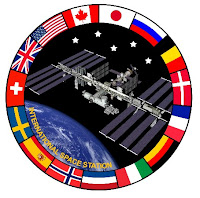ISS - International Space Station logo.
July 22, 2020
When NASA astronaut Douglas Hurley squeezed a bag of fruit punch aboard the International Space Station last month, he did not get a refreshing drink. Instead, the red fluid that emerged from his drink bag wound down a clear tube and soaked into a block of white foam.
While it might not look like much, this simple experiment is providing researchers with better information about managing liquids in microgravity.
Image above: NASA astronaut Jack Fischer performs the setup of hardware for the Capillary Structures for Exploration Life Support (Capillary Structures) two sorbent demonstrations. The Capillary Structures investigation studies a new method using structures of specific shapes to manage fluid and gas mixtures. Image Credit: NASA.
Hurley conducted his foam infill demonstration as a part of the Capillary Structures for Exploration Life Support (Capillary Structures) investigation, which studies the use of different structures and containers to manage fluids and gases. The experiment may provide researchers with a better understanding of capillary forces, the small pushes and pulls that move liquid through a narrow tube.
Capillary systems can be simpler to use than current water-purification and air-cleaning systems because they rely on specific geometric shapes and fluid dynamics rather than complex pumps and machinery to move and store liquid. Similar technology also could be used in water recovery systems, desalination plants, and other facilities on Earth.
Image above: A close-up view of the Capillary Flow Experiments-2 Vane Gap-1 (CFE-2 VG1) vessel mounted on the Maintenance Work Area. The test fluid (silicone oil with red dye) can be seen in the test chamber. Image Credit: NASA.
“Because the forces of surface tension are so small, there is almost no way to study capillary forces on the ground at the scales that we can in low gravity,” says Mark Weislogel, the experiment’s principal investigator and professor of mechanical engineering at Portland State University in Oregon.
In a microgravity environment, these tiny forces can be more easily observed. That is why Weislogel has led studies of capillary flow aboard station since the early expeditions.
“We started this long line of capillary experiments that have been going to space since about 15 years ago,” says Weislogel. “They are all small scale fluid experiments that have taught us a lot about managing fluids in space without any moving parts or electricity.”
Image above: Principal investigator Mark Weislogel and graduate student researcher Rihana Mungin work in the NASA-PSU Telescience Support Lab in Portland, Oregon. On screen, NASA astronaut Douglas Hurley conducts a foam demonstration aboard the space station. Image Credit: Mark Weislogel.
Hurley’s contributions are the latest in a line of astronaut involvement with capillary investigations during the nearly 20 years humans have lived continuously aboard the orbiting laboratory.
“The astronauts are everything to us,” says Weislogel. “We build experiments that are pretty wide open in what is possible. They have been able to take the hardware and do way more with it than we had originally planned.”
Hurley and fellow Commercial Crew Program astronaut Robert Behnken launched to the space station in May aboard a SpaceX Crew Dragon spacecraft, increasing the crew time available for science on the orbiting lab.
Fruit Punch and Foam: Managing Liquids in Space
Under Weislogel’s guidance, Hurley conducted an engineering demonstration that could inform the creation of better water purification systems for space missions. It used fruit punch, which has physical properties similar to urine, to study the fluid’s behaviors and interaction with the foam. The foam could potentially be compressed, expanded, and then thrown away when it is filled with solid wastes like crystals.
Rihana Mungin, a student investigator on the study, says Hurley’s efforts, combined with the work of the scientists on the ground, are helping the research team understand several facets of capillary systems. These aspects include how well the foam holds liquid in microgravity, how effectively it bounces back when agitated or shaken, how the liquid spreads and absorbs into the foam keeping the air passageways open, the resilience of the equipment, and more.
“It is creating this video database of what happens in all these different situations with the liquid, allowing us to push the boundaries further,” says Mungin.
The team now is analyzing footage taken during Hurley’s demonstration to better understand potential future uses of foam for fluid management.
“This is a simple piece of technology that I think will really push innovation,” says Mungin.
Related links:
Expedition 63: https://www.nasa.gov/mission_pages/station/expeditions/expedition63/index.html
Commercial Crew Program: https://www.nasa.gov/exploration/commercial/crew/index.html
Capillary Structures: https://www.nasa.gov/mission_pages/station/research/experiments/explorer/Investigation.html?#id=7329
ISS National Lab: https://www.issnationallab.org/
Spot the Station: https://spotthestation.nasa.gov/
Space Station Research and Technology: https://www.nasa.gov/mission_pages/station/research/overview.html
International Space Station (ISS): https://www.nasa.gov/mission_pages/station/main/index.html
Images (mentioned), Video (NASA), Text, Credits: NASA/Michael Johnson/JSC/International Space Station Program Research Office/Erin Winick.
Greetings, Orbiter.ch




